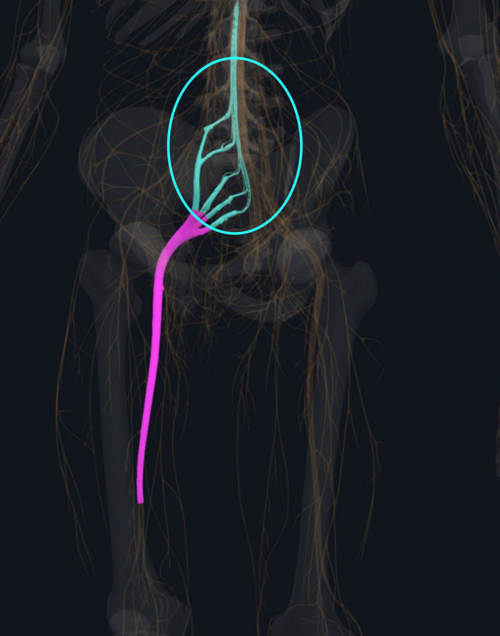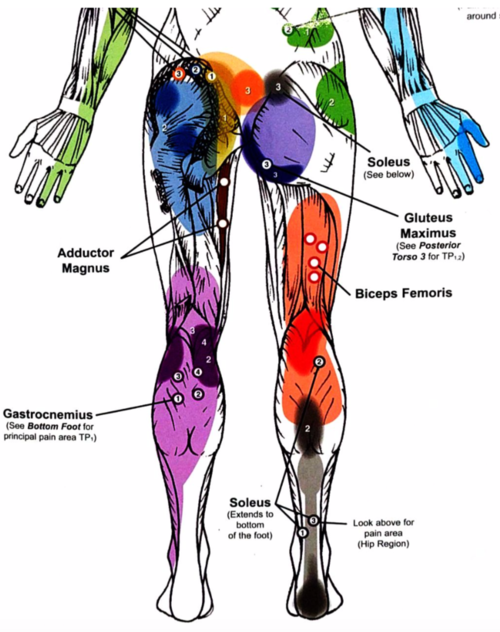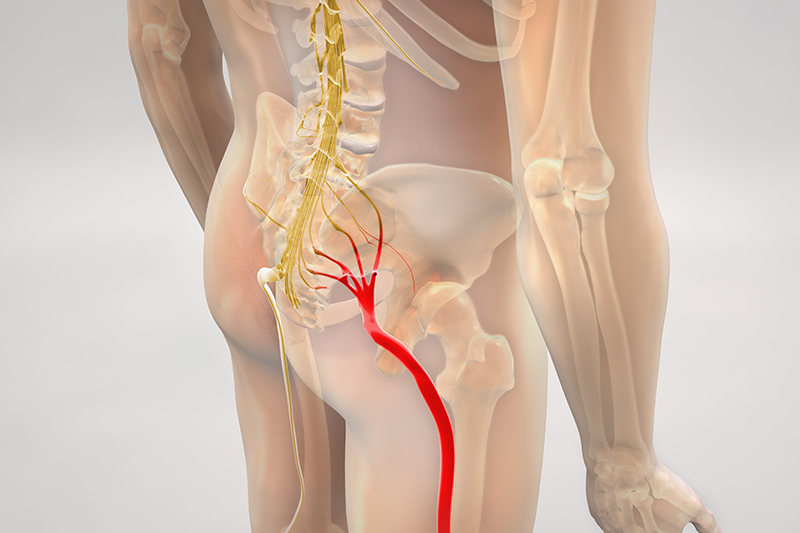What is sciatica?
Sciatica is pain in the sciatic nerve. It is not back pain. You can have back pain AND sciatica, but strictly speaking sciatica is not back pain, it is sciatic nerve irritation, and the sciatic nerve lives in the leg. Today I’ll teach you the different causes of sciatica. Along this journey of the sciatic nerve I want you to remember that nerves like their space, if their space is crowded or narrowed they get MAD, and when nerves get mad they cause pain, burning, numbness, tingling, and/or aching. Where ever the nerve gets irritated it causes symptoms down stream to all the other branches and structures below the site of irritation. Nerves have 1 or 2 functions only. Neves can carry sensory (feeling) information, control muscle action (motor), or some nerves can do both. So if a nerve is irritated you may experience sensory and/or motor symptoms. If a motor nerve is damaged you may also see atrophy (muscle shrinkage) because the motor nerve isn’t making the muscle move. If the muscle doesn’t move it shrinks. Just like if you break your arm after your cast comes off you’re not as buff as you once were because you couldn’t move and hypertrophy (bulk) the muscle. However, with nerve damage that stopping of motion isn’t happening from casting it is happening because the nerves are the electrical wiring that makes the muscles move. If you damage the electrical wires (nerves) the movement slows/stops.
Lets start this journey at the beginning of the sciatic nerve; in your back near your spine. The lower part of your spine is the lumbar spine. You have 5 lumbar bones (vertebrae) in your lower spine, then the next section of your spine is the sacrum, the sacrum is a flat bone in your backside made up of a few fused segments. This is the segment in between your lumbar spine and your tail bone (coccyx). In between each one of your vertebrae is a disc that helps with shock absorption and movement. Behind the disc is the spinal canal where your spinal cord lives.
The start of the nerve leaving the spinal cord is called the nerve root. The roots of lumbar and sacrum nerves move south to supply your lower body with sensory and motor functions. Lumbar nerve root 4 (L4), lumbar never root 5 (L5), sacrum nerve root 1 (S1), sacrum nerve root 2 (S2), and sacrum nerve root 3 (S3), leave your spine (the teal color in the picture) and join up together in your leg to form the sciatic nerve. (the pink color in the picture) This is the largest nerve in your body, so large it is about the size of a garden hose. BUT if you have a disc bulging/protruding/herniation pressing on the L4, L5, S1, S2, or S3 nerve root, that nerve gets MAD, and because L5 nerve is both in your back AND a part of your sciatic nerve you get back pain AND leg pain. But when the source of the irritation is near the nerve root and radiates (travels) down in to the leg we call this radiculopathy. Radiculopathies can even radiate all the way down to your toes. So your heel pain may actually be an S1 nerve root that is irritated and the down stream nerves that branch off the S1 nerve root are irritated. A radiculopathy is like someone just put a dam at the top of the river (nerve root) and the small creeks (nerves) that are down stream are suffering, and it can be all the way to your toes. A disc injury is actually the most common cause of sciatica. In the picture below you can see all of the nerve branches of the sciatic nerve. The teal circle is where the L4, L5, S1, S2, and S3 nerve roots leave the spine, the pink is the sciatic nerve, and the small teal branches all originate from the sciatic nerve. So if you have pain in any of these areas it may be a sciatic nerve issue, but more likely it is a nerve root issue. A nerve root that makes up part of the sciatic nerve.


But true sciatica is not a radiculopathy it is a peripheral neuropathy. “Peripheral” in the sense that it happens outside of the center of your body, outside of your spine. The sciatic nerve lives in the leg so if it is irritated outside of the spine it is a peripheral neuropathy. A well known peripheral location for the sciatic nerve to get irritated is near the piriformis. The sciatic nerve is suppose to be covered and run under the piriformis but occasional it can run over the piriformis or through the piriformis muscle.
Tight and tense muscles can also send pain down the leg. There are a few muscle that have referral patterns down the glutei and legs including: gluteus medius (blue), biceps femoris (orange), gastrocnemius(purple), soleus (grey).

The short story:
Many people use “sciatica” as a word to mean any pain that runs down your leg. But that is not entirely accurate. Pain running down your leg can be caused by a few different things like:
- Disc issues – discs can squish nerves. Squished nerves send SOS signals in the form of traveling pain. When a nerve is squished near the spine this is called radiculopathy.
- Trigger point/knot referral – Some times leg pain is not nerve pain at all, there are several muscles that when irritated can cause pain traveling down the back of the leg. This is referral pain.
- Piriformis syndrome – this is when the sciatic nerve is irritated by the piriformis muscle. The sciatic nerve is suppose to run underneath this muscle. But some times the nerve runs through the muscle.
- Canal Stenosis – This is the most difficult to treat. This is a result of the vertebrae in the spine narrowing and irritating the nerves before they exit the spine.
Classic sciatica pain is pain down the back of the leg that stops at the back of the knee. But just because your leg pain goes past the knee doesn’t mean it is not sciatic pain, every person is wired a little different, and the different causes of leg pain can present similarly. If the pain runs down the side of your leg, it is probably not sciatica. If the pain runs down the front of your leg, it is probably not sciatica. If the pain runs down the inside of your leg, it is probably not sciatica.
The best thing you can do is consult your healthcare provider to see what is causing your pain. Once we know what is causing your pain we can help create an action plan to take steps towards getting you out of pain.
At Premier Chiropractic Clinic we can help you determine the cause of your pain. Chiropractors are neuro-musculoskeletal specialists which mean we help treat conditions effecting nerves (like the sciatic), muscles (like piriformis syndrome or knot referral), and skeletal system (joint dysfunction). A chiropractor will help optimize the range of motion of the joints that the sciatic nerve passes around, lots of soft tissue work, ergonomic tips, and decreasing inflammation through diet/life style changes. If conservative treatment is not effective your chiropractor will know who to send you to for a potential pharmaceutical intervention. But chances are great that chiropractic care can help immensely.
Nutrition for Sciatica
In the mean time, reduce inflammation: eliminated all dietary stresses. The top diet allergens that cause inflammation: milk, eggs, nuts, shellfish, SUGAR, wheat, and soy. Sugar is a BIG one. Even if you don’t think you have an allergy to these items, it is a good idea to eliminate them to try to decrease inflammation through out the body. Supplements that help reduce inflammation include fish oil and tumeric, we carry both available here if you don’t have any. Here is an article in regards to 10 Proven Health Benefits of Tumeric Curcumin Supplements.
Please consult your provider before starting any new supplements, not all supplements are suited for everyone and some supplements may interact with your prescription medications.
If you haven’t already, check out Dr. Brian on TikTok, the link below is devoted to sciatic nerve.
Written by Dr. Ellora Pollard.
Dr. Pollard and Dr. Meenan are currently accepting new patients. Please call 412-341-2505 or check out our online scheduler to set up your appointment.


